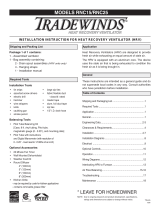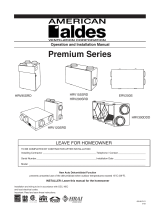Page is loading ...

Parts list. Contact factory for ordering information.
1. Remove gage from case. Set up in a vertical position using (a) the
gage stand and leveling screw on a horizontal surface or (b)
Magneclips, on a vertical steel surface.
2. Turn connectors counter-clockwise 1/2 to 3/4 turns, thus venting gage
to atmosphere.
3. Center bubble between cross hairs on spirit level with leveling screw or
by shifting gage position.
4. Slide scale to zero mark lies directly behind fluid meniscus, as shown
below.
Align fluid meniscus and the reflected image to eliminate parallax error.
5. Add or remove fluid as necessary.
6. Use left hand gage connection for plus (above atmospheric) pressures.
Connect to right side for minus (below atmospheric) pressures.
Connect to both sides for differential pressures, as with a Pitot tube.
CAUTION:
Use only Dwyer gage fluid. Clean with mild soap and water only. Other
fluids, solvents or cleaning agents may damage the gage.
AIR VELOCITY
The total pressure of an air stream flowing in a duct is the sum of the static
or bursting pressure exerted upon the sidewalls of the duct and the impact
or velocity pressure of the moving air. Through the use of a Pitot tube
connected differentially to a manometer, the velocity pressure alone is
indicated and the corresponding air velocity determined.
(-1) Gage Body
(-2) Molded Nylon Connector –
Rapid shut off type.
(-3) Leveling Screw
(-4) Scale Screw and Washer
(-5) Gage Stand, Washer and
Screw
(-6) Scale
(-7) Rubber tubing, 3/16˝ I.D.,
9 ft
(-8) Terminal Tube and Holder
(-9) 1 oz. bottle red gage fluid
(not shown)
(-10) Magneclips, Magnetic Gage
Mounting Clips (not shown)
(-11) Carrying Case (not shown)
Inclined and Vertical Portable Manometers
O
perating Instructions and Parts List
B
ulletin D-2
DWYER INSTRUMENTS INC.
MICHIGAN CITY, IN 46360 U.S.A.

For accuracy of plus or minus 2%, as in laboratory applications, extreme
c
are is required and the following precautions should be observed:
In making an air velocity check, select a location as suggested above,
c
onnect tubing leads from both Pitot tube connections to the manometer
and insert in the duct with the tip directed into the air stream. If the
manometer shows a minus indication reverse the tubes. With a direct
reading manometer, air velocities will now be shown in feet per minute. In
other types, the manometer will read velocity pressure in inches of water
and the corresponding velocity will be found from the curves on the Dwyer
website or Dwyer catalog. If circumstances do not permit an accurate
traverse, center the Pitot tube in the duct, determine the center velocity
and multiply by a factor of .9 for the approximate average velocity. Field
tests run in this manner should be accurate within plus or minus 5%.
The velocity indicated is for dry air at 70°F (21.3°C), 29.9” Barometric
Pressure and a resulting density of .075=/cu. ft. For other variations from
these conditions, corrections may be based upon the following data:
STATIC PRESSURE
In checking inlet and discharge fan and blower pressures, balancing
ventilation and dust collection systems, checking exhaust systems and
similar installations, air velocities above 700 ft. per min. (12.81 kms/hr)
can cause an appreciable error. It is recommended that the static
connection of the Pitot tube or a static pressure tip be used. In using the
static pressure tip or Pitot tube, the tip should be directed into the air
stream. For permanent installation, static pressure tips are recommended.
If not available, make connections, enter the duct perpendicular to the air
stream and finish off flush and smooth on the inside.
FURNACE DRAFT
Connect the terminal tube to the minus pressure gage opening and insert
it into the combustion chamber for over fire draft reading. If a drilled port
is not available insert through fire door but seal the crack. For last pass or
smoke pipe draft, connect into the breeching on the furnace side of any
draft control or damper. To determine draft loss through the furnace, make
connection as indicated for smoke pipe draft and add a second tube,
connecting the manometer differentially to the combustion chamber.
AIR FILTER TEST
To determine the pressure drop across an air filter, connect the
manometer differentially with one tubing from the downstream or blower
side of the filter to the right hand or minus pressure gage connection. Run
the second tubing from the upstream side of the filter to the other gage
connection. Use static pressure tips if available, with the tips directed into
the air stream, to eliminate possibility of error due to air velocity. Read the
pressure drop across the filter in inches of water and follow the filter
manufacturer’s recommendations for filter cleaning or replacement.
1
. Duct diameter 4˝ (8.64 mm) or greater.
2. Make an accurate traverse per sketch
at right and average the readings.
3. Provide smooth, straight duct sections
10 diameters in length both upstream
a
nd downstream from the Pitot tube.
4. Provide an egg crate type straightener
u
pstream from the Pitot tube.
©Copyright 2013 Dwyer Instruments Inc. Printed in U.S.A. 5/13 FR# 30-440078-00 Rev. 9
35D
60D
8
0D
92D
D
DWYER INSTRUMENTS INC.
MICHIGAN CITY, IN 46360 U.S.A.
Air Velocity = 1096.2 P
V
D
where P
V
= velocity pressure in inches of water; D= Air density in =/cu. ft.
Air Density = 1.325 x P
B
T
where P
B
= Barometric Pressure in inches of mercury; T = Absolute
Temperature (indicated temperature plus 460)
Flow in cu. ft. per min. = Duct area in square feet x air velocity in ft. per
minute.
1/2

